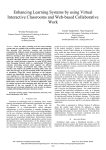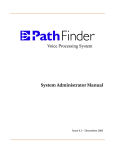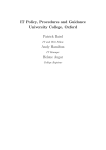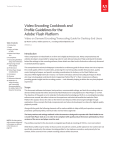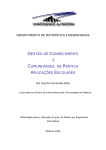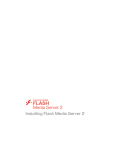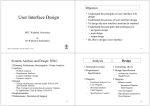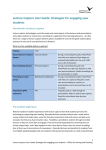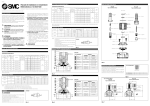Download Enhancing Learning Systems by using Virtual Interactive
Transcript
Enhancing Learning Systems by using Virtual Interactive Classrooms and Web-based Collaborative Work Wichian Premchaiswadi Graduate School of Information Technology in Business Siam University Bangkok, Thailand [email protected] Abstract— There are many e-learning web sites and e-learning systems that are available with excellent content and design but they generally lack interactive response and face-to-face communication. Students cannot ask questions and get responses immediately. It is similar to one way communication for learning. However, learning is most effective when it actively constructs knowledge during group social interaction and collaboration. Therefore, this paper proposes to inspire creativity in e-learning called the virtual interactive classroom by using RTMP (RealTime Messaging Protocol) which is a sophisticated TCP-based real-time networking protocol which supports the efficient exchange of messages, synchronized data, audio, and video. Teachers and students can publish streaming audio, video and other data messages to present streaming media with interaction or navigation. Using this virtual classroom on the internet, students can immediately interact with teachers as though they were studying in a real classroom. In addition to the virtual interactive classroom, this article also proposes using web-based collaborative work as an add-on feature to the learning system. Both teacher and student can use web-based collaborative work for sharing resources and exchanging ideas after the class. The integration of the two concepts of the virtual interactive classroom and web-based collaborative work in order to enhance teaching and learning performance has been created. Keywords- learning system; virtual interactive classroom; webbased collaborative work, Wikis I. INTRODUCTION Advances in technologies such as streaming video, virtual learning environments and teleported experiments are entering the Web-based learning arena [19]. Along with the development of a second-generation online education infrastructure, it will be necessary to consider changing the interface of web-based education such as reinventing pedagogy for the new interface, including multimedia and hypermedia enhancements as well as creating the educational standards necessary for generalized deployment. Instructional learning goals should drive media selection, applications, and the course development process. Characteristics of the distance learner and the impact of technology are also important considerations in instructional media selection and course development. The new streaming technologies have made it easier than ever for Anucha Tungkasthan1, Nipat Jongsawat2 Graduate School of Information Technology in Business Siam University Bangkok, Thailand 2 [email protected], [email protected] people to receive a quality education by bringing the classroom to the student. Imagine, a teacher at one university campus delivering a lecture while students in a classroom two cities away watch the same lecture in real time. In a residence hall not far away, a student recovering from an operation watches a lecture recorded from an earlier class he or she had missed that is delivered on-demand in the comfort of his or her own room. In a city 5,000 kilometers away, a student is using the ondemand lectures to take part in the same course delivered completely online [6]. With the advent of streaming technology and the possibilities it creates, scenarios like these have been repeated all over the world. In addition to the virtual interactive classroom, this article also proposes web-based collaborative work as an add-on feature to the learning system. Teachers can assign a task or a group task as homework to the students after studying using a real-time internet classroom. They can also manage group work using the various tools provided in an application. They can use the system to monitor and evaluate the student’s behavior during collaborative work. Students can collaborate or help each other and generate additional ideas to solve a given task. Using the two important features – the virtual interactive classroom and web-based collaborative work- in a learning system, both teachers and students can greatly benefit from distance learning. These features will enhance the performance of teaching and learning for distance learning. The key goals for this research were the development of: (a) a lightweight virtual interactive classroom, and (b) a web-based collaborative application. This article is organized as follows: Section II addresses about the related work. Section III addresses a design framework for web application. Section IV describes about supporting technologies in more detail. Section V describes the implementation. Section VI presents conclusion and gives some perspectives and ideas for future work. II. RELATED WORK Traditional study using a blackboard provides a rich interaction between lecturer and learner that cannot easily be replaced with a PowerPoint slideshows. Satoshi Ichimura et al present a ChalkTalk system [20]. It is a system that automatically produces e-learning materials from a videotaped chalk talk lecture in front of an ordinary blackboard or whiteboard. But this approach lacks interaction activity. The Learning Activity Management System (LAMS) [12] provides more student interaction such as question and answer (with student answers shared with the group), asynchronous discussion forum, and synchronous chat. Based on the pilot evaluation of LAMS, only 15% of students were willing to discuss ideas in front of their peers in the classroom, but over 80% of the same students were willing to discuss their ideas within LAMS. E-learning provides for self-managed learning such that the learner can study when they want, but some people still like traditional teaching, where the lecture times are fixed [18]. Tungkasthan, et al presents an implementation of an interactive virtual classroom on Internet [23]. They implement several methods for the efficient exchange of messages, synchronized data, audio, and video by using a real-time messaging protocol. Their application allows multiple connected users to share data and user interfaces in real time. Currently, there are many collaboration and communication programs on the market such as NetMeeting, CollabWorx Virtual Classroom, Breeze, MSN, or Skype. Some programs are free and some are not. Each program has pros and cons. Let’s us consider the features offered in each program. NetMeeting [16] is a synchronous online collaboration and communication program. This means that NetMeeting collaboration with others happens in “real time.” NetMeeting allows users to implement online meetings, hold online classes, and conference with individuals no matter how distant they may be. Some of the NetMeeting features also allow for efficient communication with people with certain disabilities such as hearing or mobility impairments. NetMeeting is an application sharing, which is suitable for online meeting or video/audio conference. The program still lacks some essential features for online virtual classroom such as classroom control, presentation control, and content review. CollabWorx Virtual Classroom [5] is a complete software solution enabling interactive, real-time delivery of corporate training or academic classes over the network. The process involves an instructor and support personnel at one geographical location and a group of students at remote locations. Both parties (instructor(s) and students) use desktop computers as the only communication device. The notion of "remote" encompasses distances from "across the hallway" to "across the continent." This program contains full functionalities for online classroom but it still lacks of some interactive response portions for the students. Skype [21] is a peer-to-peer Internet telephony network. Skype has experienced rapid growth in both popular usage and software development since launch, both of its free and its paid services. The Skype communications system is notable for its broad range of features, including free voice and video conferencing, its ability to use peer to peer (decentralized) technology to overcome common firewall and NAT (Network address translation) problems, and its extreme countermeasures against reverse engineering of the software or protocol. This program is not appropriate to apply with virtual classroom because of lacking tools for class management and learner collaboration functions. Macromedia Breeze [2] is software used with Microsoft PowerPoint to create information and general presentations, online training materials, web conferencing, and learning modules. Macromedia Breeze includes four applications: Breeze Presenter, Breeze Training, Breeze Meeting, Breeze Events. This program is generally designed for conducting a meeting purpose not a virtual classroom but it can creatively apply to virtual classroom as well. Sakai [24] is an enterprise application that supports teaching, learning and scholarly collaboration in either fully or partially online environments. It provided powerful functions with a suite of capabilities for faculty, students and staffs. Some of the many available tools in Sakai include general collaboration tools, teaching and learning tools, portfolio tools, and administrative tools. Moodle [25] is similar to Sakai. Moodle is an open source course management system (CMS). It is very popular among educators around the world as a tool for creating online dynamic web sites for the learners. Moodle has several features such as module, quiz module, forum module, and resource module that allow it to scale to very large deployments and hundreds of thousands of learners. However, such main features available with Moodle are essentially provided and supported for individual interactive learning. Although, there are the rich array of tools and features that are available with the Sakai and Moodle but such tools are mainly used for non-interactive mode. Another technology enhanced learning approach proven to enhance especially informal learning is the application of Wikis as collaborative online tools [10]. Wikis are a technology developed by Leuf and Cunningham in 1995 [15]. They are designed to provide a simple tool for knowledge management, with users being able to collaboratively create and edit pages. Another of the central aspects of a Wiki is the revision history tracing every modification to a specific user. Recently, tools like wikis are being used to support collaborative aspects in e-learning [8]. With the power of Web2.0 technologies, wikis seem to be an appropriate tool for exchange between high numbers of learners. Lot of different research work carried out that wikis can successfully be applied in education [3], [7]. Wikis in general highly support the characteristics communication, collaboration and contribution to a pool of knowledge. Depending on the degree of freedom as well as the possibilities of active contributions within a learning community successful learning occurs [4], [17]. Furthermore, there is an impact for graduates on cooperative developing new knowledge as solving problems [13]. III. A DESIGN FRAMEWORK FOR WEB APPLICATION A. A Framework and its Functions There are two main components in the proposed design framework for the web application. First, it is a virtual interactive classroom. There are some requirements that should be taken into consideration such as: 1) shared object component, and 2) VDO streaming component. In the first component, there are many objects such as a white board, presentation, chat, AV presence and list of people in the interactive classroom on the internet. These can be shared with other students. Remote shared objects are managed by a streaming server. Clients can access shared objects and get updates whenever a change is made to a shared object. The VDO streaming component is also provided by the streaming server. Second, it is a web-based collaborative work component. It consists of a workspace, chat room, comment tool, and e-mail. The framework and its details are shown in Fig 1. Figure 1. Top level design and classification function of virtual internet classroom. B. Client/Server Sequential Process for Virtual Interactive Classroom There are four steps in the sequential process utilized to obtain streaming objects. First, a client requests the HTML and SWF files by using HTTP on a TCP connection. Second, the web server sends HTML with embedded links and SWF files back to the client according to their request. Third, the client sends a message to a flash media server by using the RTMP protocol. Fourth, shared FLV files and streaming media are sent back to the client. The general connecting and displaying of shared files as well as streaming media are shown in Fig. 2. Figure 2. Procedural sequence steps in general connecting and displaying share and streaming media. C. Collaborative Functions for Lecturer and Learner in a Virtual Interactive Classroom 1) Login function: When a student or teacher wants to enter the classroom, they must login with the correct username and password. In the classroom, they are allowed to use shared objects or resources. 2) Whiteboard function: The purpose of using this function is to provide a collaborative environment for students and teachers. They can write messages in text format and draw lines on a shared whiteboard environment in real time. When they want a message or line, they must select tools by dragging and dropping them on the whiteboard. They can also delete objects by pressing the delete key on the keyboard. Students can write or erase any items at any time they want. Students and teachers have equal authority in this classroom. 3) Presentation function: This function allows creating a presentation in SWF format. This function contains two modes. The first mode is the teacher mode. The teacher can fully control the presentation. Students can see the same presentation frame simultaneously. The second mode is the student mode. Students can navigate the presentation by using next and back buttons in order to view the presentation. They are not allowed to control the presentation that the teacher is using. The presentation function requires an SWF presentation file. 4) Chat function: This function supports teacher and students for chatting in regular text format. They can send message to their friends in the same classroom. Text can be selected in different styles. 5) List of learners: This function displays teacher and student names that are logged into the classroom. All usernames appear on the list in the classroom and are used to identify who they are. 6) Audio/Video presentation function: This is very important function for providing face to face communication. A VDO camera and microphone are essential for this function. The teacher and his/her students can send and receive audio and video within the same classroom. If someone is sending audio or video or both, the other people in the classroom can see and hear it. D. Web-Based Collaborative Work The web-based collaborative application was developed using a wiki-style, WikkaWiki [11]. It provides several features such as a workspace, comment tool, chat room, and e-mail. Teachers and students can communicate with each other by editing text messages in the workspace. Teachers can assign tasks in the teacher’s workspace and students can put the solutions to such tasks in their own workspace. Teachers can post a comment to the students or students can communicate with teacher or their colleagues using the comment tool. A chat room is also provided for them to communicate with each other in real-time. An e-mail system is provided to them for sending and receiving e-mails more smoothly and conveniently. IV. SUPPORTING TECHNOLOGIES A. Overview for Flash Media Server Architecture The Macromedia Flash Media Server (FMS) platform consists of two parts: the server, which provides the means of communication, and the Macromedia Flash Player. Applications consist of a client Macromedia Flash Movie (SWF file) that is run by the Flash Player. Server components are shared with all clients. The server component minimally consists of an application folder that we have created on the server side running the Flash Media Server. This folder can optionally contain Server-Side Communication ActionScript (ASC) files and other resource files used by the communication application. The server and the Flash client application communicate over a persistent connection using the Real-Time Message Protocol (RTMP). In a typical scenario, the Flash client is delivered to the Flash Player by a web server over HTTP. The Flash client then establishes a persistent connection to the Flash Media Server using RTMP, allowing for an uninterrupted data stream to flow between the client and the server [9], [22]. The RTMP protocol of communication for Streaming media is shown in Fig. 3. [1]. The connection flow between clients the server is shown in Fig. 4. Figure 4. Connection flow between clients and server using RTMP protocol. D. Shared Objects Remote shared objects are managed by the Flash Media Server. The server provides messaging, data synchronization, and data storage services. Flash clients connect or subscribe to a remote shared object and receive updates whenever a change is made to that shared object. Also, messages can be sent to all clients connected to a remote shared object. A remote shared object can persist across application sessions, or be temporary [1]. The shared objects provide data storage and synchronization services for clients are shown in fig. 5. Figure 3. Flash media server provides a RTMP protocol of communication for Streaming media for client. B. RTMP The Real-Time Messaging Protocol (RTMP) is a protocol for client-server communication. It is a proprietary protocol developed by Adobe Systems (formerly developed by Macromedia) that is primarily used with the Macromedia Flash Media Server to stream audio and video over the internet to the Flash Player client, but can also be used for general remote procedure calls (RPC). RTMP is basically a TCP/IP protocol designed for high-performance transmission of audio, video, and data messages [14]. C. Client-Server Connection Flow When the client connects to the server, the server calls the application start method to run. Next, the server-side will make and hold the connection. The logic in this method determines whether to accept or reject the connection. Back on the client side, the “on status” handler is called to report whether the connection was accepted or rejected. When the client closes the connection, the server-side disconnects and closes the session Figure 5. Shared objects provide data storage and synchronization services for clients. E. A Lightweight Wiki Engine The web-based collaborative application was developed using a wiki-style, WikkaWiki[11]. WikkaWiki is a lightweight wiki engine written in PHP, which uses MySQL to store pages. It can be easily extended or adapted for many different uses. By setting the appropriate access privileges and using appropriate actions, the user can turn WikkaWiki into different applications, tailored to user needs. The traditional idea behind the concept of a wiki is to create a digital blackboard on which any user, either registered or anonymous, can write modifications and add comments. WikkaWiki can be used as a public wiki, discussion forum, blog, invisible backend for a personal website, intranet CMS, personal organizer and memory support, presentation framework, community-maintained user manual, and etc. V. IMPLEMENTATION A. Participants Thirty undergraduate students who registered in the multimedia course in the computer engineering department at Siam University were recruited to participate in the virtual classroom on the Internet application for a semester which lasts for four months. The teacher and students use a virtual interactive classroom on the Internet instead of using a traditional classroom for learning and teaching. Figure 6. A screenshot of a user login web page. B. Virtual Interactive Classroom and Web-based Collaborative Work 1) A Virtual Interactive Classroom: We installed the virtual classroom as an Internet application on a streaming web server. A Flash media server and IIS must also be installed on the server. We tested the application and corrected the bugs in the application for two months before it was ready. The client side must contain the flash player application in order to display flash movies correctly. The experiment is set up and run on a windows platform. Fig. 6 shows a screenshot of a user login web page. A student and teacher must login with the correct username and password to enter virtual classroom. In the classroom, they are allowed to use shared objects or resources. Fig. 7 shows a screenshot of a virtual interactive classroom. The classroom has four main portions: 1) the picture screens for the teacher and students, 2) a workspace, 3) a list of people screen, and 4) a real-time chat screen. In this virtual classroom, the teacher has the full authority to control all kinds of things such as a white board, presentation, chat, and audio/video presence by clicking on a menu item above the workspace. For example, the teacher can just click on the presentation button to control the powerpoint slideshows. The students cannot edit any contents of the slideshows. Next, the teacher clicks on the whiteboard button to change the workspace to a shared whiteboard. This feature allows anyone in the classroom to edit text messages or draw a picture on the whiteboard. The VDO feature is used in two aspects. First, the teacher clicks on the VDO button to select the VDO file in the computer and play it. Second, the students click on the VDO button to record what their teacher is teaching. Moreover, the teacher can talk to the students and/or the students can also talk to their friends in the classroom through a microphone. The teacher can mute the voice of any students by clicking on the mute button. Using a web camera, they have access to a large amount of information about one another. The students can observe how their friends feel physically and emotionally. Both teacher and students can enter a web-based collaborative work by clicking on the Collabwork button. Fig. 8 shows a screenshot of a whiteboard function. Figure 7. A screenshot of a virtual interactive classroom application. Figure 8. A screenshot of a whiteboard function. 2) A Web-based Collaborative Work: A web-based collaborative work capability was installed on a web server. It was created for a teacher who taught a multimedia course and used it for managing tasks or assignments for the students. The teacher posted a task every week on a teacher’s workspace. The students were arranged into teams to solve the given task. Using a web-based collaborative application, the students can collaborate or help each other to solve the given task, share the resources and materials, and generate additional ideas through the student’s workspace and in the comment area. In addition to the task assignment and problem solving, the teacher can use this tool to monitor the progress of the given task and the student’s behavior during an online collaborative work. The screenshots of the web-based collaborative work application are shown in fig. 9, 10, and 11. Figure 11 A screenshot of achat room in a web-based collaborative application. VI. Figure 9. A screenshot of a web-based collaborative work homepage. Figure 10 A screenshot of a comment tool in a web-based collaborative application. CONCLUSION AND FUTURE WORK This article presents the potential of integrating two concepts, namely those of a virtual interactive classroom and a web-based collaborative work application in order to enhance teaching and learning performance in distance learning. In addition to the concepts, the framework has been designed and implemented. The virtual interactive classrooms and the webbased collaborative work application work well according to their predefined functions. They can work as a substitute for any classroom in the school. With the use of computers and information technologies, the barriers of space and time can be eliminated. This virtual interactive classroom is an opportunity for a number of students in rural areas with homes that are far away from a school. They have a chance to study and communicate with the teacher and other students. We do not mean to imply that by using this virtual interactive classroom on the internet that it is better than the real classroom in the school but it is a choice in order to move schools closer to students who lack of the opportunity of physically attending a school. We want the virtual interactive classrooms on the internet to be one standard feature of several possible features for e-learning or distance learning. In future research, based on this study, we intend to summarize the feedback received from teachers and students and take the results and recommendations obtained from the experiment into the consideration for improving the quality of the virtual interactive classroom and web-based collaborative work application in the future. REFERENCES [1] [2] [3] Adobe Systems Incorporated, “LiveDocs (online Documentation),” Macromedia Flash Media Server Documentation, Adobe System Incorporated, 2007. Adobe Systems Incorporated, “Macromedia Breeze,” Adobe System Incorporated, 2007. http://www.adobe.com/products/breeze/index.html Augar, N., R. Raitman, et al., “Teaching, Learning Online with Wikis,” Beyond the Comfort Zone: proceedings of the 21st ASCILITE conference, 2004, pp. 95-104. [4] [5] [6] [7] [8] [9] [10] [11] [12] [13] [14] A. Bruns and S. Humphreys, “Wikis in Teaching and Assessment: The M/Cyclopedia Project,” Proceedings of the ACM WikiSym 05: Internation Symposium on Wikis, San Diago, USA, 2005. CollabWorx, Inc, “CollabWorx Virtual Classroom,” CollabWorx, Inc, 2007. http://www.webwisdom.com/Products/vclassroom.html Creative Commons, “RealMedia Development Site,” Elearnspace, 2006. http://www.elearnspace.org/doing/media.html M. Ebner, M.D. Kickmeier-Rust, et al.,“Utilizing Wiki-Systems in Higher Education Classes: a chance for universal access? Universal access in the Information society,” Heidelberg, Berlin, New York, Springer, 2008. F. Kittowski, A. Kohler., “Roughing up Processes the wiki Way – Knowledge Communities in the Context of Work and Learning Processes,” I-know, 2004, pp. 484-493. Giacomo Guilizzoni, “Creating Your First Broadcast with Flash Communication Server MX,” Flash Communication Server Article, Developer center, 2007. http://www.adobe.com/devnet/flashcom/articles/broadcast.html G. Granitzer, A. Stocker, et al., “Informal Learning with Semantic Wikis in Enterprises,” World Conference on Educational Multimedia, Hypermedia and Telecommunication (ED-MEDIA), AACE, 2005, pp. 6165-6170. http://wikkawiki.org James Dalziel, “Implementing Learning Design: The Learning Activity Management System (LAMS),” ASCILITE, 2003, pp593-596. P.A. Kirschner, P. Van Vilsteren, et al., “A Study Environment for Aquiring Academic and Professional Competence,” Studies in Higher Education 22(2), 1997, pp. 151-171. Kristopher Schultz, “Taking Control of Connects,” Flash Communication Server Article, Developer Center 2007. www.adobe.com/devnet/flashcom/articles/connections.html [15] B. Leuf and W. Cunningham, “The Wiki way: Quick collaboration on the Web,” Upper Saddle River, NJ, USA: Addison Wesley, 2001. [16] Microsoft corporation , “Window Net Meeting,” Microsoft corporation, 2007. http://www.microsoft.com/windows/netmeeting [17] T.J.F. Mitchell, S.Y. Chen et al. “Hypermedia Learning and Prrior Knowledge: Domain Expertise vs. System Expertise,” Journal of Computer Assisted Learning 21(1), 2005, pp.53-64. [18] M. Smith, “Use of Web-based curriculum and assessment in the teaching of Information Systems subjects,” ITICA, 2002. http://www.adobe.com/support/documentation/en/flashmediaserver/ [19] Nishikant Sonwalkar, “Changing the Interface of Education with Revolutionary Learning Technologies,” Campus Technology, 2001. http://campustechnology.com/articles/38896 [20] Satoshi Ichimura, “Delivering Chalk Talks on the Internet,” International Conference on System Sciences, IEEE 2007. [21] Skype Limited, “Skype 3.1,” Skype Limited, 2007. http://www.skype.com/intl/en/download [22] Srinivas Manapragada, Giacomo Guilizzoni, “Understanding the Component Framework,” Flash Communication Server Article, Developer Center 2007. www.adobe.com/devnet/flashcom/articles/framework.html [23] A. Tungkasthan and W. Premchaiswadi, “An Implementation of an Interactive Virtual Classroom on Internet,” Proceeding of ED-MEDIA, World Conference on educational Multimedia, Hypermedia & Telecommunications, 2007, pp. 1299-1304. [24] http://sakaiproject.org/features [25] http://moodle.org







